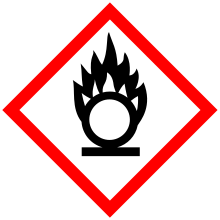Barium nitrate
Barium nitrate is the inorganic compound with the chemical formula Ba(NO3)2. It, like most barium salts, is colorless, toxic, and water-soluble. It burns with a green flame and is an oxidizer; the compound is commonly used in pyrotechnics.[3]
 | |
| Names | |
|---|---|
| Other names
Barium dinitrate, , barium salt | |
| Identifiers | |
3D model (JSmol) |
|
| ChEMBL | |
| ChemSpider | |
| ECHA InfoCard | 100.030.006 |
| EC Number |
|
PubChem CID |
|
| RTECS number |
|
| UNII | |
| UN number | 1446 |
CompTox Dashboard (EPA) |
|
| |
| |
| Properties | |
| Ba(NO3)2 | |
| Molar mass | 261.337 g/mol |
| Appearance | white, lustrous crystals |
| Odor | odorless |
| Density | 3.24 g/cm3 |
| Melting point | 592 °C (1,098 °F; 865 K) (decomposes) |
| 4.95 g/100 mL (0 °C) 10.5 g/100 mL (25 °C) 34.4 g/100 mL (100 °C) | |
| Solubility | insoluble in alcohol |
| -66.5·10−6 cm3/mol | |
Refractive index (nD) |
1.5659 |
| Structure | |
| cubic | |
| Hazards | |
| Safety data sheet | See: data page |
| GHS pictograms |    |
| GHS Signal word | Danger |
GHS hazard statements |
H272, H301, H302, H319, H332 |
| P210, P220, P221, P261, P264, P270, P271, P280, P301+310, P301+312, P304+312, P304+340, P305+351+338, P312, P321, P330, P337+313, P370+378, P405, P501 | |
| NFPA 704 (fire diamond) | |
| Flash point | noncombustible[1] |
| Lethal dose or concentration (LD, LC): | |
LD50 (median dose) |
355 mg/kg (oral, rat) 187 mg/kg (rat, oral)[2] |
LDLo (lowest published) |
79 mg Ba/kg (rabbit, oral) 421 mg Ba/kg (dog, oral)[2] |
| NIOSH (US health exposure limits): | |
PEL (Permissible) |
TWA 0.5 mg/m3[1] |
REL (Recommended) |
TWA 0.5 mg/m3[1] |
IDLH (Immediate danger) |
50 mg/m3[1] |
| Supplementary data page | |
| Refractive index (n), Dielectric constant (εr), etc. | |
Thermodynamic data |
Phase behaviour solid–liquid–gas |
| UV, IR, NMR, MS | |
Except where otherwise noted, data are given for materials in their standard state (at 25 °C [77 °F], 100 kPa). | |
| Infobox references | |
Manufacture, occurrence, and reactions
Barium nitrate is manufactured by two processes that start with the main source material for barium, the carbonate. The first involves dissolving barium carbonate in nitric acid, allowing any iron impurities to precipitate, then filtered, evaporated, and crystallized. The second requires combining barium sulfide with nitric acid.[3]
It occurs naturally as the very rare mineral nitrobarite.[4]
At elevated temperatures, barium nitrate decomposes to barium oxide:
- 2Ba(NO3)2 → 2BaO + 4NO2 + O2
Applications
Barium nitrate is used in the production of BaO-containing materials.
Military
Although no longer produced, Baratol is an explosive composed of barium nitrate, TNT and binder; the high density of barium nitrate results in baratol being quite dense as well. Barium nitrate mixed with aluminium powder, a formula for flash powder, is highly explosive. It is mixed with thermite to form Thermate-TH3, used in military thermite grenades. Barium nitrate was also a primary ingredient in the "SR 365" incendiary charge used by the British in the De Wilde incendiary ammunition with which they armed their interceptor fighters, such as the Hawker Hurricane and Supermarine Spitfire, during the Battle of Britain.[5] It is also used in the manufacturing process of barium oxide, the vacuum tube industry and for green fire in pyrotechnics.
Safety
Like all soluble barium compounds, barium nitrate is toxic by ingestion or inhalation.[6]
Solutions of sulfate salts such as Epsom salts or sodium sulfate may be given as first aid for barium poisoning, as they precipitate the barium as the insoluble (and non-toxic) barium sulfate.
Inhalation may also cause irritation to the respiratory tract.
While skin or eye contact is less harmful than ingestion or inhalation, it can still result in irritation, itching, redness, and pain.
The Occupational Safety and Health Administration and the National Institute for Occupational Safety and Health have set occupational exposure limits at 0.5 mg/m3 over an eight-hour time-weighted average.[7]
References
- NIOSH Pocket Guide to Chemical Hazards. "#0046". National Institute for Occupational Safety and Health (NIOSH).
- "Barium (soluble compounds, as Ba)". Immediately Dangerous to Life and Health Concentrations (IDLH). National Institute for Occupational Safety and Health (NIOSH).
- Kresse, Robert; Baudis, Ulrich; Jäger, Paul; Riechers, H. Hermann; Wagner, Heinz; Winkler, Jocher; Wolf, Hans Uwe (2007). "Barium and Barium Compounds". In Ullman, Franz (ed.). Ullmann's Encyclopedia of Industrial Chemistry. Wiley-VCH. doi:10.1002/14356007.a03_325.pub2.
- Mindat, http://www.mindat.org/min-2918.html
- Williams, Anthony G; Emmanuel Gustin (2004). "THE BATTLE OF BRITAIN: ARMAMENT OF THE COMPETING FIGHTERS". Flying Guns: World War 2. Crowood Press. Archived from the original on 5 January 2013. Retrieved 23 December 2012.
The B. Mk VI 'De Wilde' incendiary (named after the original Belgian inventor but in fact completely redesigned by Major Dixon), which contained 0.5 grams of SR 365 (a composition including barium nitrate which ignited on impact with the target) was twice as effective as these, scoring one in five.
- Barium Nitrate
- CDC - NIOSH Pocket Guide to Chemical Hazards
| HNO3 | He | ||||||||||||||||
| LiNO3 | Be(NO3)2 | B(NO 3)− 4 |
RONO2 | NO− 3 NH4NO3 |
HOONO2 | FNO3 | Ne | ||||||||||
| NaNO3 | Mg(NO3)2 | Al(NO3)3 | Si | P | S | ClONO2 | Ar | ||||||||||
| KNO3 | Ca(NO3)2 | Sc(NO3)3 | Ti(NO3)4 | VO(NO3)3 | Cr(NO3)3 | Mn(NO3)2 | Fe(NO3)2 Fe(NO3)3 |
Co(NO3)2 Co(NO3)3 |
Ni(NO3)2 | CuNO3 Cu(NO3)2 |
Zn(NO3)2 | Ga(NO3)3 | Ge | As | Se | Br | Kr |
| RbNO3 | Sr(NO3)2 | Y(NO3)3 | Zr(NO3)4 | Nb | Mo | Tc | Ru(NO3)3 | Rh(NO3)3 | Pd(NO3)2 Pd(NO3)4 |
AgNO3 Ag(NO3)2 |
Cd(NO3)2 | In | Sn | Sb(NO3)3 | Te | I | Xe(NO3)2 |
| CsNO3 | Ba(NO3)2 | Hf | Ta | W | Re | Os | Ir | Pt(NO3)2 Pt(NO3)4 |
Au(NO3)3 | Hg2(NO3)2 Hg(NO3)2 |
TlNO3 Tl(NO3)3 |
Pb(NO3)2 | Bi(NO3)3 BiO(NO3) |
Po(NO3)4 | At | Rn | |
| FrNO3 | Ra(NO3)2 | Rf | Db | Sg | Bh | Hs | Mt | Ds | Rg | Cn | Nh | Fl | Mc | Lv | Ts | Og | |
| ↓ | |||||||||||||||||
| La(NO3)3 | Ce(NO3)3 Ce(NO3)4 |
Pr(NO3)3 | Nd(NO3)3 | Pm(NO3)3 | Sm(NO3)3 | Eu(NO3)3 | Gd(NO3)3 | Tb(NO3)3 | Dy(NO3)3 | Ho(NO3)3 | Er(NO3)3 | Tm(NO3)3 | Yb(NO3)3 | Lu(NO3)3 | |||
| Ac(NO3)3 | Th(NO3)4 | PaO2(NO3)3 | UO2(NO3)2 | Np(NO3)4 | Pu(NO3)4 | Am(NO3)3 | Cm(NO3)3 | Bk | Cf | Es | Fm | Md | No | Lr | |||
